Related Research Articles

John Knox was a Scottish minister, Reformed theologian, and writer who was a leader of the country's Reformation. He was the founder of the Presbyterian Church of Scotland.

Mary of Guise, also called Mary of Lorraine, was Queen of Scotland from 1538 until 1542, as the second wife of King James V. She was a French noblewoman of the House of Guise, a cadet branch of the House of Lorraine and one of the most powerful families in France. As the mother of Mary, Queen of Scots, she was a key figure in the political and religious upheaval that marked mid-16th-century Scotland, ruling the kingdom as queen regent on behalf of her daughter from 1554 until her death in 1560.
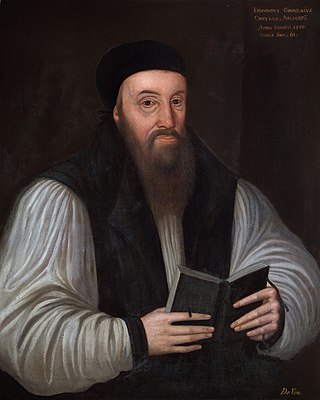
Edmund Grindal was Bishop of London, Archbishop of York, and Archbishop of Canterbury during the reign of Elizabeth I. Though born far from the centres of political and religious power, he had risen rapidly in the church during the reign of Edward VI, culminating in his nomination as Bishop of London. However, the death of the King prevented his taking up the post, and along with other Marian exiles, he was a supporter of Calvinist Puritanism. Grindal sought refuge in continental Europe during the reign of Mary I. Upon Elizabeth's accession, Grindal returned and resumed his rise in the church, culminating in his appointment to the highest office.

John Rogers was an English clergyman, Bible translator and commentator. He guided the development of the Matthew Bible in vernacular English during the reign of Henry VIII and was the first English Protestant executed as a heretic under Mary I of England, who was determined to restore Roman Catholicism.
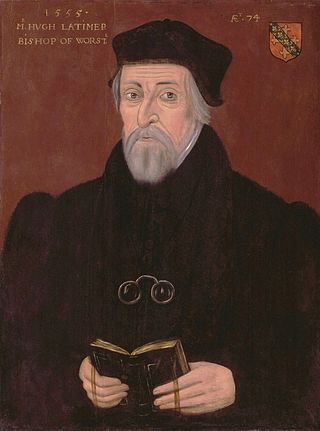
Hugh Latimer was a Fellow of Clare College, Cambridge, and Bishop of Worcester during the Reformation, and later Church of England chaplain to King Edward VI. In 1555 under the Catholic Queen Mary I he was burned at the stake, becoming one of the three Oxford Martyrs of Anglicanism.
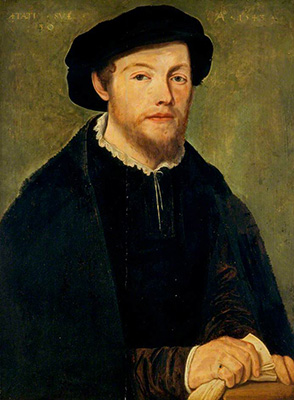
George Wishart was a Scottish Protestant Reformer and one of the early Protestant martyrs burned at the stake as a heretic.

David Beaton was Archbishop of St Andrews and the last Scottish cardinal prior to the Reformation.

Patrick Hamilton was a Scottish churchman and an early Protestant Reformer in Scotland. He travelled to Europe, where he met several of the leading reformed thinkers, before returning to Scotland to preach. He was tried as a heretic by Archbishop James Beaton, found guilty and handed over to secular authorities to be burnt at the stake in St Andrews as Scotland's first martyr of the Reformation. In no other country in the world was the Reformation so complete or as thorough as in Scotland. This country was moved by the martyrdom of Patrick Hamilton in 1528. Hamilton began preaching in Scotland in 1527 and was invited as a friend by Archbishop Beaton to a conference in St. Andrews. Once there, he was charged with heresy and burned. After Hamilton's death, others who had New Testaments or who professed Reformed doctrines were burned or sentenced to severe punishments, and some fled the country. The clergy were held up to ridicule all over the land.
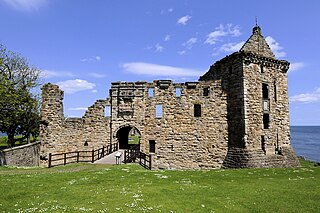
St Andrews Castle is a ruin located in the coastal Royal Burgh of St Andrews in Fife, Scotland. The castle sits on a rocky promontory overlooking a small beach called Castle Sands and the adjoining North Sea. There has been a castle standing at the site since the times of Bishop Roger (1189–1202), son of the Earl of Leicester. It housed the burgh’s wealthy and powerful bishops while St Andrews served as the ecclesiastical centre of Scotland during the years before the Protestant Reformation. In their Latin charters, the Archbishops of St Andrews wrote of the castle as their palace, signing, "apud Palatium nostrum."

Robert Ferrar was a Bishop of St David's in Wales.
John Lauder was Scotland's Public Accuser of Heretics. He was twice sent to Rome by King James V, to confirm the loyalty of the Scottish crown. As Principal Private Secretary to Cardinal David Beaton, Archbishop of St. Andrews, he successfully prosecuted many heretics, who were burnt at the stake, John Knox testifying to his extreme cruelty. Beaton was eventually murdered by the mob, but Lauder escaped and was later Private Secretary to Archbishop Hamilton.

Walter Milne, also recorded as Mill or Myln, was the last Protestant martyr to be burned in Scotland before the Scottish Reformation changed the country from Catholic to Presbyterian.
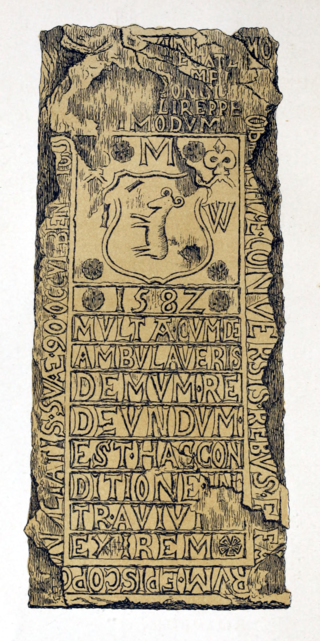
John Winram was a 16th-century Scottish priest and ecclesiastical reformer. He was born in 1492, the son of one James Winram of Ratho and his wife Margaret Wilkie. He obtained a Bachelor's Degree (1515), a Master's Degree and a Doctorate (1541) from St Leonard's College, University of St Andrews.
Christopher Goodman BD (1520–1603) was an English reforming clergyman and writer. He was a Marian exile, who left England to escape persecution during the counter-reformation in the reign of Queen Mary I of England. He was the author of a work on limits to obedience to rulers, and a contributor to the Geneva Bible. He was a friend of John Knox, and on Mary's death went to Scotland, later returning to England where he failed to conform.

John Craig was a Reformer, and colleague of John Knox. Originally a Dominican, he became a Church of Scotland minister with significant extra responsibilities and played an influential part in the Scottish Reformation.
Thomas Forret, was vicar of Dollar, Clackmannanshire, and a Scottish martyr.

The siege of St Andrews Castle (1546–1547) followed the killing of Cardinal David Beaton by a group of Protestants at St Andrews Castle. They remained in the castle and were besieged by the Governor of Scotland, Regent Arran. However, over 18 months the Scottish besieging forces made little impact, and the Castle finally surrendered to a French naval force after artillery bombardment. The Protestant garrison, including the preacher John Knox, were taken to France and used as galley slaves.

The Troubles at Frankfurt was a name given retrospectively to internal quarrels of the Marian exiles in Frankfurt am Main in the mid-1550s, involving also the Scottish reformer John Knox. Politically, Frankfurt was a Free Imperial City of the Holy Roman Empire.
The London underground church was an illegal Puritan group in the time of Elizabeth I and James I. It began as a radical fringe of the Church of England, but split from the Church and later became part of the Brownist or puritan Separatist movement. William Bradford, Governor of Plymouth Plantation, cited the underground church as the first that ‘professed and practised the cause’ of the Pilgrim Fathers.
References
- 1 2 Foxe 1583, page 2054.
- ↑ Knox 1846, page 187.
- 1 2 Knox 1846, page 96.
- ↑ Knox 1846, pages 188–91.
- ↑ Knox 1846, pages 200–1.
- ↑ Dasent, John Roche, ed. (1893). Acts of the Privy Council of England, New Series, Vol. VI, AD 1556–8. London: Eyre and Spottiswoode. p. 216.
- 1 2 Tomkins, Stephen (2020). The Journey to the Mayflower. London and New York: Hodder & Stoughton. p. 15. ISBN 9781643133676.